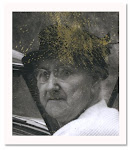All you needed were
six eight mules and a harness with bells and you were in business. Oh sure, you needed a wagon or two, and some rough and tumble fellas to drive the rig, but if you did you would surely garner the attention of a fair maiden with a camera.
Location and people unknown. Time period long ago when farming was done by people, not corporations. Oh wait, corporations are people too. I nearly forgot that little gem of wisdom.
 Click on image to see it larger.
Click on image to see it larger.







This is great photo. They look like a matched set. I've always liked mules, maybe because Festus on Gunsmoke rode one and was always praising them.
ReplyDeleteSo of course I had to go look up "bells on mules". The following explanation comes from Owensvalleyhistory.com - The Jingle of Mule Teams. The wagons hauled heavy silver and gold bullion bars.
The first two animals in front of the lead wagon were called the "wheelers" - usually heavy draft horses who
could support the tongue and take the shocks of the vehicle. The rest were mules, who could stand more
hardships and were more easily managed in the long harness than the high-strung horses. Next pair ahead of the
wheel horses were the "swings," or "pointers," who were hitched to a heavy chain extending beyond the end of
the tongue. In front of these plodded the "sixes," then the "eights," the "tens," the "twelves," all pulling the
wagons by means of that long "swing chain" which hung about a foot from the ground.
At the head of the team stepped the "leaders," each wearing a bow of jingling bells arched over the collar;
by this means fast-moving vehicles were warned of the approach of the two-mile-an-hour bullion teams around
a blind bend. On turning such a corner the inside swing mule, and sometimes one of the sixes as well, had to
jump over the chain and pull at counter angles with his partner to keep the wagon from going straight up to the
point of turning,
Riding the near wheeler, the mule skinner controlled his team with a blacksnake whip and a jerk-line rope
running from the lead wagon's brake handle through harness rings to the near leader's halter. A jerk on that line
meant a right turn, a steady pull meant a left. With each outfit rode a "swamper," the driver's assistant. During
the day's travel he usually handled the brake on the rear wagon; in camp he helped to hitch and unhitch the
mules and make repairs on wagons and harness.
Well this is pretty funny and amazing because I was going to pose the question, "Hey, does anyone know what gives with the bells?" So you did what I was hoping would happen! Thanks for clearing this up. I can now sleep soundly tonight.
DeleteI love the shadow of the photographer. It is a kind of half a - what would be called at the moment - selfie.
ReplyDeleteI hadn't thought of that, but you're right. Perhaps people should start taking selfie-shadow shots.
DeleteCool beans! I'm glad Mike added a bunch to an already cool photo!
ReplyDeleteYes, he made the post.
Delete